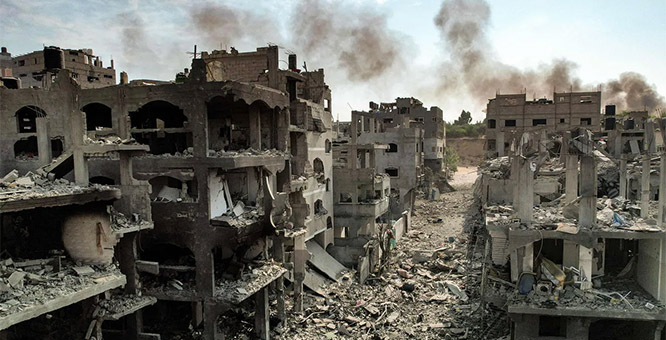The genocidal war on Gaza launched by Israel on October 7 last year, with the support of the US and its other Western allies, completes 200 days on Tuesday, leaving behind a trail of death, destruction, displacement and starvation.
These 200 days – between October 7, 2023, and April 23, 2024 – have been marked by unprecedented crimes against the people of Gaza, especially children and women, the bombardment of hospitals and schools, abuse and torture of women and abduction of young boys.
Human rights groups and international bodies have described the harrowing events unfolding in the besieged Palestinian territory as a textbook case of genocide and ethnic cleansing.
Israeli regime’s key international allies – Washington, London, Paris and Berlin – have also been at the receiving end of massive public backlash for their continued military support for the regime.
The death toll in the apartheid regime’s genocidal campaign has already topped 34,150 since October 7, more than 75 percent of them being women and children, according to the Gaza government office.
The 2.3 million people in the besieged territory continue to deal with a catastrophic humanitarian crisis amid relentless bombings and crippling siege imposed by the Israeli regime with the backing of the US.
Following are the statistics related to 200 days of war waged by the Israeli occupation on Gaza.
200 – the number of days of the latest Israeli genocidal war on Gaza
41,183 – the total number of those killed and missing in Gaza since Oct. 7
34,183 – the total number of fatalities in Gaza since Oct. 7 (confirmed dead)
7,000 – the number of people still under the rubble of destroyed buildings in Gaza (presumed dead)
77,183 – the number of wounded persons in Gaza since Oct. 7
3,025 – the number of massacres committed by the regime since Oct. 7
14,778 – the number of children killed since Oct. 7
30 – the number of children who died due to starvation and famine
9,752 – the number of women killed since Oct. 7
485 – the number of doctors and paramedics killed since Oct. 7
67 – the number of civil defense personnel killed since Oct. 7
140 – the number of Palestinian journalists killed since Oct. 7
72 – the percentage of children and women killed since Oct. 7
17,000 – the number of children who have lost one or both parents since Oct. 7
11,000 – the number of injured people who need to travel for treatment
10,000 – the number of cancer patients who face the risk of death
1,090,000 – the number of people with infectious diseases due to displacement
8,000 – the number of cases of viral hepatitis due to displacement
60,000 – the number of pregnant women at risk due to lack of healthcare
350,000 – the number of chronically ill patients suffering due to lack of medicine
5,000 – the number of people arbitrarily detained in Gaza since Oct. 7
310 – the number of health practitioners who have been arrested
20 – the number of known journalists arbitrarily detained since Oct. 7
2 million – the number of displaced people in the Gaza Strip
181 – the number of government buildings destroyed since Oct. 7
103 – the number of schools and universities completely destroyed since Oct. 7
317 – the number of schools and universities partially destroyed by the occupation
239 – the number of mosques completely destroyed since Oct. 7
317 – the number of mosques partially destroyed since Oct. 7
3 – the number of churches targeted and destroyed since Oct. 7
86,000 – the number of housing units completely destroyed since Oct. 7
294,000 – the number of housing units partially destroyed since Oct. 7
75,000 – tons of explosives dropped by the occupation on Gaza since Oct. 7
32 – the number of hospitals taken out of service by the occupation since Oct. 7
53 – the number of health centers that have become non-functional since Oct. 7
160 – the number of health institutions partially or fully destroyed since Oct. 7
126 – the number of ambulances destroyed by the occupation army since Oct. 7
206 – the number of archaeological and heritage sites destroyed since Oct. 7
$30 – billions in preliminary direct losses as a result of the genocidal war on Gaza









Comments
Add new comment